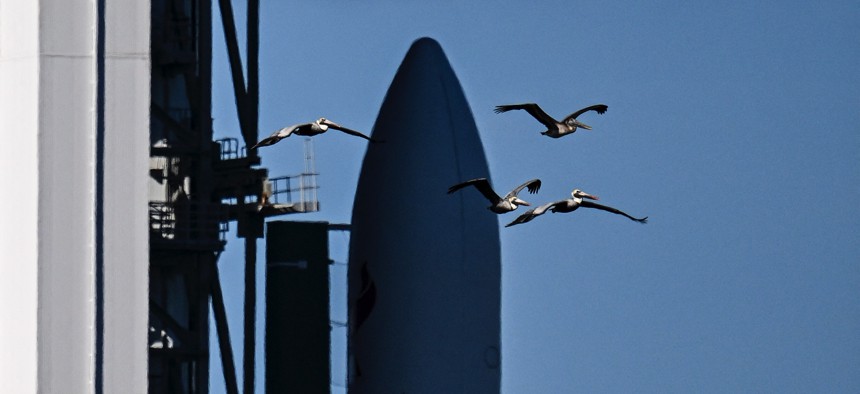
Pelicans fly past the United Launch Alliance (ULA) Vulcan Centaur rocket as it is transported to Space Launch Complex 41 at Cape Canaveral Space Force Station in Cape Canaveral, Florida, on January 5, 2024. CHANDAN KHANNA/AFP via Getty Images
Inside Space Force's budget priorities and spending patterns
In the past 12 months, the youngest service has awarded contracts worth an estimated $11.9 billion.
Space Force may have just celebrated its fourth birthday in December, but the newest military branch's budget has grown quickly over that short time.
Analysis by Forecast International and GovTribe indicates the Space Force is asking for a $30 billion budget for the 2024 fiscal year, which began in October but which Congress has yet to pass. The request represents a 15% increase over fiscal 2023 and would be Space Force's largest budget to date.
The biggest chunk, of $4.9 billion, would go toward operations and maintenance, followed by $4.7 billion for contracts/procurement. Research and development has a request of $2.6 billion and personnel is next at $1.2 billion.
David Hutchins, a senior analyst at Forecast International, presented his findings on Friday at Washington Technology's Power Breakfast event focused on Space Force. Forecast International and Washington Technology are sister brands of Defense One.
Hutchins' analysis showed that Space Force priorities include better missile warning and missile tracking, training and education, and a theme called “resiliency through proliferation.”
Resiliency through proliferation reflects the high growth of low-Earth-orbit satellites and their importance to communications and data transport. They also play a critical role in sensing and positioning-navigation-timing capabilities.
Hutchins said that one of Space Force's top priorities is protecting these satellites, many of which are owned by commercial entities.
Space Force also is driving the National Security Space Launch program for acquiring more launch vehicles and driving down the cost of launches. That program is Space Force’s top-funded line item, he said.
The need for a proliferated network of low-Earth-orbit satellites is a critical lesson from the conflict in Ukraine, where commercial systems such as Starlink have played a key role in Ukrainian military operations.
Hutchins estimates that Space Force has issued about $11.9 billion in contract awards over the last 12 months, based on GovTribe data.
R&D NAICS code 541715 was the top code, with $3.3 billion in awards, followed by engineering services (541330) at $1.6 billion, and guided missile and space vehicle manufacturing (336414) at $1.1 billion.
OASIS and OASIS Small Business are the top contract vehicles with $450 million and $463 million in fiscal 2023 obligations, respectively. Sounding Rocket Program 4 was the third with $80 million in obligations.
Some of the top recompetes in fiscal 2024 include Delta IV Heavy Launch Services with a $1.6 billion ceiling; Base Maintenance Services at Thule Air Base in Greenland, worth $487 million; and delivery of prototype satellites valued at $529 million.
Hutchins also recommended several Space Force organizations for identifying and tracking opportunities:
- COMSO – The Commercial Space Office, which focuses on accelerating commercial partnerships.
- SSC Front Door – A portal for industry to track opportunities and further engage with Space Force.
- SpaceWERX – The innovation arm of Space Force.
- COSMIC – the Commercial Space Marketplace for Innovation and Collaboration, an organization that also facilities collaboration between industry and Space Force’s Space Systems Command.




